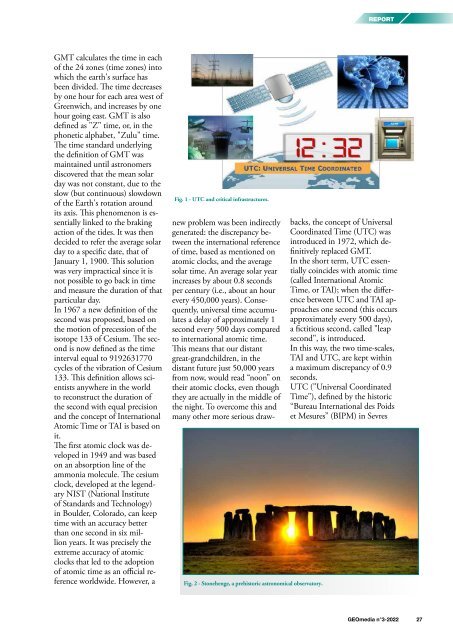Create successful ePaper yourself
Turn your PDF publications into a flip-book with our unique Google optimized e-Paper software.
REPORT<br />
GMT calculates the time in each<br />
of the 24 zones (time zones) into<br />
which the earth's surface has<br />
been divided. The time decreases<br />
by one hour for each area west of<br />
Greenwich, and increases by one<br />
hour going east. GMT is also<br />
defined as "Z" time, or, in the<br />
phonetic alphabet, "Zulu" time.<br />
The time standard underlying<br />
the definition of GMT was<br />
maintained until astronomers<br />
discovered that the mean solar<br />
day was not constant, due to the<br />
slow (but continuous) slowdown<br />
of the Earth's rotation around<br />
its axis. This phenomenon is essentially<br />
linked to the braking<br />
action of the tides. It was then<br />
decided to refer the average solar<br />
day to a specific date, that of<br />
January 1, 1900. This solution<br />
was very impractical since it is<br />
not possible to go back in time<br />
and measure the duration of that<br />
particular day.<br />
In 1967 a new definition of the<br />
second was proposed, based on<br />
the motion of precession of the<br />
isotope 133 of Cesium. The second<br />
is now defined as the time<br />
interval equal to 9192631770<br />
cycles of the vibration of Cesium<br />
133. This definition allows scientists<br />
anywhere in the world<br />
to reconstruct the duration of<br />
the second with equal precision<br />
and the concept of International<br />
Atomic Time or TAI is based on<br />
it.<br />
The first atomic clock was developed<br />
in 1949 and was based<br />
on an absorption line of the<br />
ammonia molecule. The cesium<br />
clock, developed at the legendary<br />
NIST (National Institute<br />
of Standards and Technology)<br />
in Boulder, Colorado, can keep<br />
time with an accuracy better<br />
than one second in six million<br />
years. It was precisely the<br />
extreme accuracy of atomic<br />
clocks that led to the adoption<br />
of atomic time as an official reference<br />
worldwide. However, a<br />
Fig. 1 - UTC and critical infrastructures.<br />
Fig. 2 - Stonehenge, a prehistoric astronomical observatory.<br />
new problem was been indirectly<br />
generated: the discrepancy between<br />
the international reference<br />
of time, based as mentioned on<br />
atomic clocks, and the average<br />
solar time. An average solar year<br />
increases by about 0.8 seconds<br />
per century (i.e., about an hour<br />
every 450,000 years). Consequently,<br />
universal time accumulates<br />
a delay of approximately 1<br />
second every 500 days compared<br />
to international atomic time.<br />
This means that our distant<br />
great-grandchildren, in the<br />
distant future just 50,000 years<br />
from now, would read “noon” on<br />
their atomic clocks, even though<br />
they are actually in the middle of<br />
the night. To overcome this and<br />
many other more serious drawbacks,<br />
the concept of Universal<br />
Coordinated Time (UTC) was<br />
introduced in 1972, which definitively<br />
replaced GMT.<br />
In the short term, UTC essentially<br />
coincides with atomic time<br />
(called International Atomic<br />
Time, or TAI); when the difference<br />
between UTC and TAI approaches<br />
one second (this occurs<br />
approximately every 500 days),<br />
a fictitious second, called "leap<br />
second", is introduced.<br />
In this way, the two time-scales,<br />
TAI and UTC, are kept within<br />
a maximum discrepancy of 0.9<br />
seconds.<br />
UTC ("Universal Coordinated<br />
Time"), defined by the historic<br />
“Bureau International des Poids<br />
et Mesures” (BIPM) in Sevres<br />
<strong>GEOmedia</strong> n°3-<strong>2022</strong> 27


















